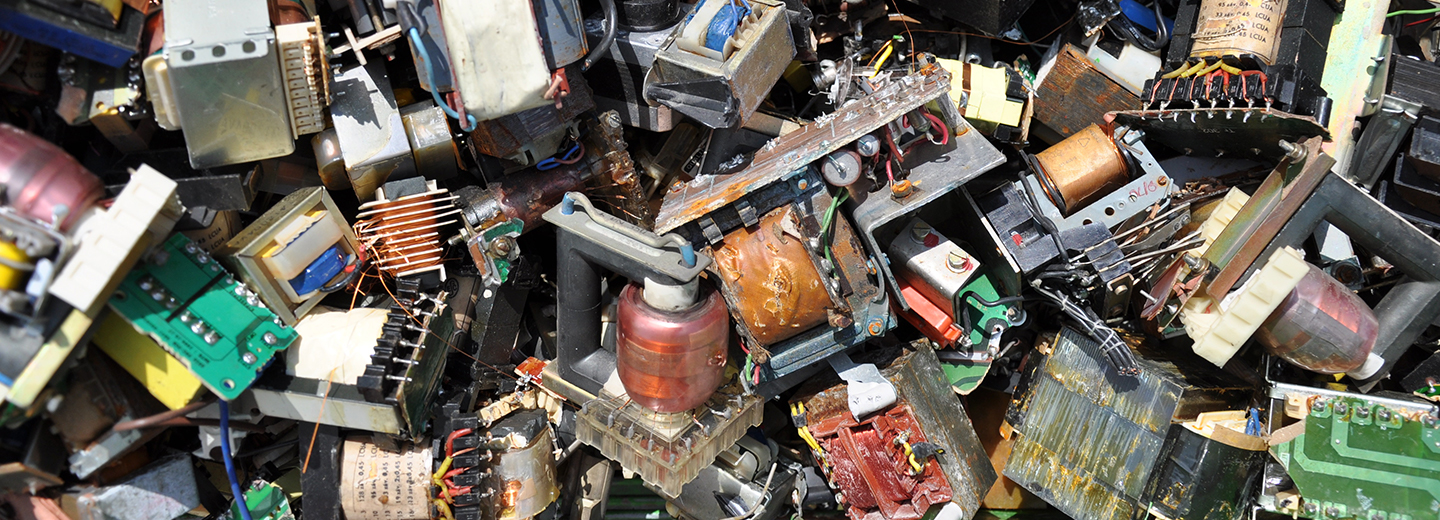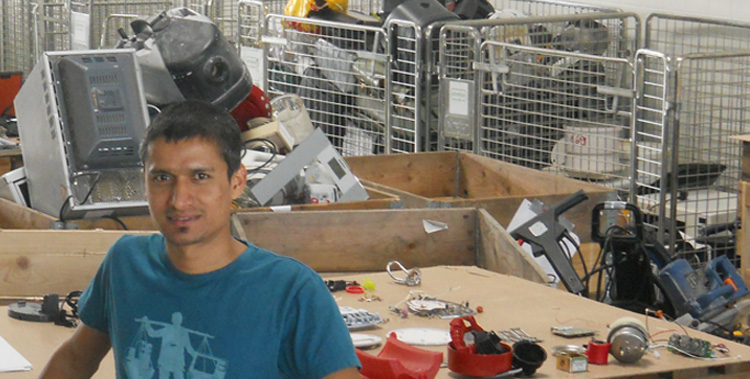
We buy and discard more and more electronic devices
E-waste is today the fastest-growing type of waste and poses a global threat to the environment. “We need to get rid of our use–and-throw-away culture and think in terms of circular economics,” says a researcher from the University of Southern Denmark.
By Bente Dalgaard, bda@sdu.dk
When you have to pay someone 300 kroner an hour to get a repair done on the blender you once paid 100 kroner for, it’s probably a good idea to discard it and buy a new one.
If you feel bad about this kind of use-and-throw-away culture, you might want to follow Keshav Parajuly’s example and try to repair it yourself.
“The switch in my blender had broken, so I tried to open it. It was difficult because it hadn’t been assembled with a standard type of screw. But when I got hold of the right tool, I could see there was a high-quality motor and it was just a poor switch that was defective. It turned out that I couldn’t get the spare parts needed to repair it, so I eventually just had to throw the blender away,” says Keshav Parajuly.
He works at the SDU Life Cycle Centre, where he researches in circular economics focusing on e-waste, i.e. electrical and electronic products of all kinds – mobile phones, computers, shavers, refrigerators, vacuum cleaners, printers, hand mixers, hair dryers, washing machines, etc. – that people can no longer use, or simply don’t want to use any more.
The fastest-growing waste stream
“In the last 50 to 100 years, we have seen the invention and development of many different e-products, but the technology for ensuring that these products or materials are reused hasn’t kept up with this growth. The amounts of e-waste are growing globally by 50 million tons a year, and this is now considered to be the fastest-growing single waste stream of all,” explains Keshav Parajuly.
This kind of waste is not limited by national borders, most often flowing from affluent countries to developing countries that have not yet established a structure to deal with e-waste in an environmentally responsible manner.
According to Keshav Parajuly, “Developing countries are willing to accept waste of this kind because they are able to extract materials like copper and steel from it, and to earn money by doing so. This does not involve recycling for environmental reasons, and often uses primitive methods that can be dangerous to themselves and to nature.”
All too often, parts of computers and other e-products are simply burned out in the open to extract the metals that can be sold. The emissions from burning plastic and metal can be toxic, and there is a risk of long-term environmental contamination from the major disposal and incineration sites, including substances such as lead and arsenic.
70 different metals inside your mobile phone
“For the environment, the best thing would be that we all deal with our own waste and develop systems that can ensure that products and materials are recycled most appropriately. But it can be very expensive to create these systems, because e-products are often very complex,” says Keshav Parajuly and points out that mobile phones frequently contain as many as 70 different metals.
“When a mobile phone is designed, the emphasis is on making the phone smarter and slimmer – and not on creating a design that makes it easier to reuse the metal components when the phone doesn’t work any more. Recovery of these 70 component metals corresponds to separating and extracting the sugar, milk, water and coffee in a cup of coffee. That’s why many valuable metals are currently being lost, and we are seeing an ever-increasing strain on the environment,” he points out.
Revenue opportunities required
According to Keshav Parajuly, the circular economy is the solution to this because the components or materials contained in the discarded products are recycled, and therefore maintain as much value as possible.
The big challenge, however, is to develop business models that enable manufacturers as well as companies in disposal, recycling and waste management to see financial benefits from participating in a circular economy in which both e-products and materials have a longer life.
“Today, the whole system associated with e-products and e-waste is fragmented. The parties involved don’t communicate with each other, and they have no incentive to leave the consume-and-throw-away culture. Many valuable resources – including rare metals that are often in scarce supply – are lost as a result of this,” says Keshav Parajuly.
Researchers at the University of Southern Denmark will now be able to work with these issues for a three-year period. The university management has selected a number of projects in which SDU has particularly good opportunities to create value for society, and provided financial support for these.
Platform in preparation
As a result, SDU Life Cycle Centre has become coordinator in a project involving researchers from different disciplines working together to develop a platform that supports circular economy thinking with regard to e-products. The E-circle platform is designed to be a forum where anyone with an interest in recycling and recycling of e-waste can get both practical help and good ideas.
“For example, we would like manufacturers to post drawings of the products along with data about the materials and components used in them. Companies that buy discarded e-products and dismantle them to sell recyclable product parts and raw materials could benefit from this. This would help them identify which materials have financial value and how they can best dismantle the product without spoiling the recyclable parts and materials,” explains Keshav Parajuly. “Conversely, those who design and manufacture e-products could benefit from case stories about what other companies did, and guidelines that show them how to alter the design so more parts can be reused when the product reaches the end of its service life.”
1000 different strategies
“There aren’t any major manufacturers of electronic and electrical products in Denmark, but the platform means people in different countries can work together, sharing information that can help ensure more environmentally responsible handling of our e-waste. Perhaps our legislators might even be inspired to pass measures appropriate to the times we live in, and the general consumer can get good advice about e-waste,” points out Keshav Parajuly.
He also emphasises that there are over 1000 different kinds of e-products, and that different strategies are needed for the best circulation of each individual product. A car is a big investment that you don’t just throw away because a couple of parts aren’t working properly. You get it repaired, and even if it is discarded, it is still valuable because many parts can be recycled.
“But it’s different with things like a hair dryer. If it cannot be repaired, the financial and environmental costs associated with recycling may be greater than with simply burning it. Here, the best overall strategy might be to design it to last for 20 years, and then sell it at a higher price,” explains Keshav Parajuly.

In 2017, SDU researcher Keshav Parajuly was in charge of a project in which nearly five tons of e-waste from recycling stations in the Danish city of Odense were inspected and tested. The project showed that 22% of the small household appliances that people had discarded actually still worked. However, the percentage of appliances in working order when disposed of is actually greater than that, because many items break when they are thrown into the cages at local recycling stations. Keshav estimates that the net gain from recycling the 25,000 tons of household appliances discarded each year would be between DKK 65 and 140 million.
Read more:
Meet the researcher
Keshav Parajuly is a postdoctoral researcher at the Department of Chemistry, Biology and Environmental Technology at the University of Southern Denmark (Syddansk Universitet – SDU), where he is affiliated with the SDU Life Cycle Centre. In 2017, he defended his PhD thesis entitled “Circular Economy in E-waste management. Resource Recovery and Design for End-of-Life.”
Circular economy
We extract raw materials, manufacture products, consume them, throw them away and then acquire new ones. One result of this is that many resources are wasted – including valuable rare metals – and these rapidly growing amounts of waste also constitute a problem for our environment. The circular economy is an alternative system that can ensure more sustainable management of the Earth’s resources. The idea is to enable these products – or the materials from which they are made – to circulate within our society’s different systems for as long as possible. This can be done by designing longer-lasting products, by reusing and repairing products, and by recycling materials from discarded products in new products. An important feature of the circular economy involves moulding innovative business models that give businesses clear financial incentives to think in terms of sustainability – both when designing new products and when they need to get rid of waste in the most environmentally responsible manner.